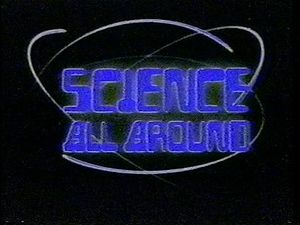Difference between revisions of "Science All Around - Sound"
Martinwguy (talk | contribs) (→Availability) |
Martinwguy (talk | contribs) |
||
| Line 1: | Line 1: | ||
{{Thumb|Science All Around title}} | {{Thumb|Science All Around title}} | ||
| − | Delia created music for a programme "Sound" in the BBC Schools TV series [[Science All Around]], commissioned by producer [[Robin Gwyn]] for BBC1. | + | Delia created music for a programme "Sound" in the BBC Schools TV series [[Science All Around]], commissioned by producer [[Robin Gwyn]] for BBC1. Delia's plan for the piece describes it as a: |
| + | <BLOCKQUOTE> | ||
| + | Sig. for Science prog. ‘What's going to happen next’<BR> | ||
| + | atmos. of intrigue (not Dr. Who), light and enjoyable<BR> | ||
| + | a tune with ground bass of 6 main harmonics and countermelody — 1 min. | ||
| + | </BLOCKQUOTE> | ||
| + | made from the sounds of things vibrating: a bowed plate and an ascillator.<ref>[[DD081643]]: Delia's notes for ''Science All Around''.</ref> | ||
The piece's creation starts with a phone call from [[Robin Gwyn]] to the workshop, which is taken down in pencilled notes for Desmond Briscoe, who then forwards the work to Delia, who realises something inspired by the resonance patterns that form on Chladni plates in response to different sounds. | The piece's creation starts with a phone call from [[Robin Gwyn]] to the workshop, which is taken down in pencilled notes for Desmond Briscoe, who then forwards the work to Delia, who realises something inspired by the resonance patterns that form on Chladni plates in response to different sounds. | ||
Revision as of 13:28, 8 February 2019
Delia created music for a programme "Sound" in the BBC Schools TV series Science All Around, commissioned by producer Robin Gwyn for BBC1. Delia's plan for the piece describes it as a:
Sig. for Science prog. ‘What's going to happen next’
atmos. of intrigue (not Dr. Who), light and enjoyable
a tune with ground bass of 6 main harmonics and countermelody — 1 min.
made from the sounds of things vibrating: a bowed plate and an ascillator.[1]
The piece's creation starts with a phone call from Robin Gwyn to the workshop, which is taken down in pencilled notes for Desmond Briscoe, who then forwards the work to Delia, who realises something inspired by the resonance patterns that form on Chladni plates in response to different sounds.
The tape's catalogue entry is dated June 1971 but the tape is not to be found.[2]
Papers
DD081626: Scrap of Delia's notes: "Science all around / Michael Toyle [...] Filming here Monday all day"
DD081643: Delia's plan for the piece: "Sound, 9-11 [...] Sig. for science prog. [...] Rec. June 23rd"
DD081659: Pencilled letter from Robin Gwyn to Desmond Briscoe for a programme about Shnadlies [Chladni's!] plate, forwarded to Delia.
DD081729: Delia's notes: "Master final to Athos"
DD081743: Delia's plan for a day's work when someone visits by taxi.
DD081756: Diagrammatic score
DD081808: Diagrammatic chord sequences
DD081825: Drawings of resonating Chladni's plates "A+ C+ F- E+ D C Bb-B"
DD081841: Drawings of resonating Chladni's plates "B- F#+ D+ F#+ G#- E+ G#-"
DD081913: Delia's manuscript including "Impromptu: It came light whilst I was doing my arithmetic"
DD081955: Delia's manuscript "K/bd tuned to F# 710"
Score
DD081913
- The input file for the Lilypond music typesetting program
- Lilypond's output as a MIDI file that you can play on your computer
- An audio file of the MIDI performed on a cheesy electric piano
 |
|
| Problems listening to this file? See media help. | |
DD081955
- The input file for the Lilypond music typesetting program
- Lilypond's output as a MIDI file that you can play on your computer
- An audio file of the MIDI performed on a cheesy electric piano
 |
|
| Problems listening to this file? See media help. | |
Availability
- Broadcast on BBC1 on the 6th and 11th October 1971.[3]
- The BBC Sound Archive's tape TRW 7420 is not to be found.[2]
References
- ↑ DD081643: Delia's notes for Science All Around.
- ↑ 2.0 2.1 The Tape Library List's entry for TRW 7420.
- ↑ "science+all+around%3A+Sound"&yf=1971&yt=1971 Search results for "Science All Around: Sound" in 1971 on the BBC Genome Project.












